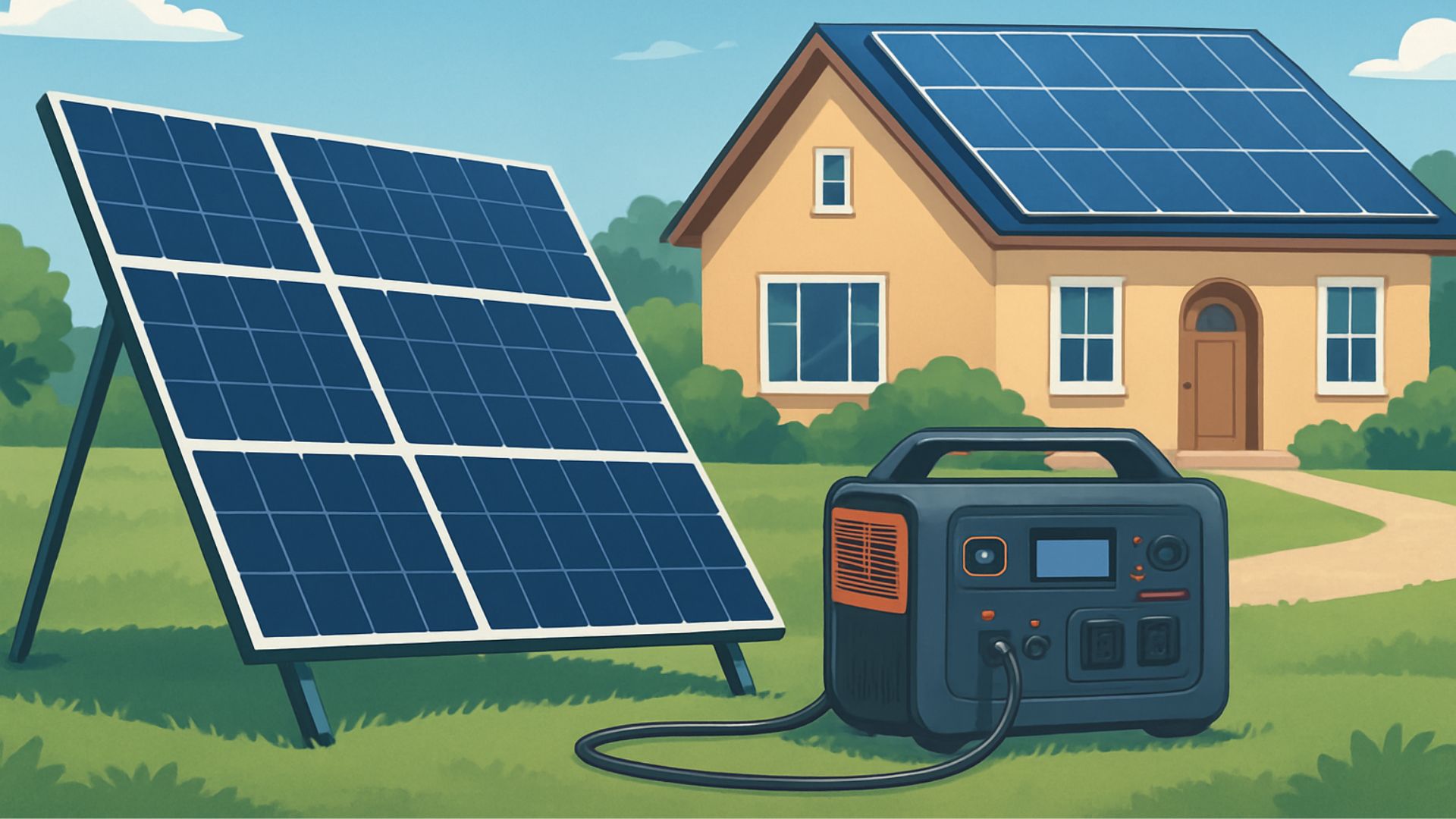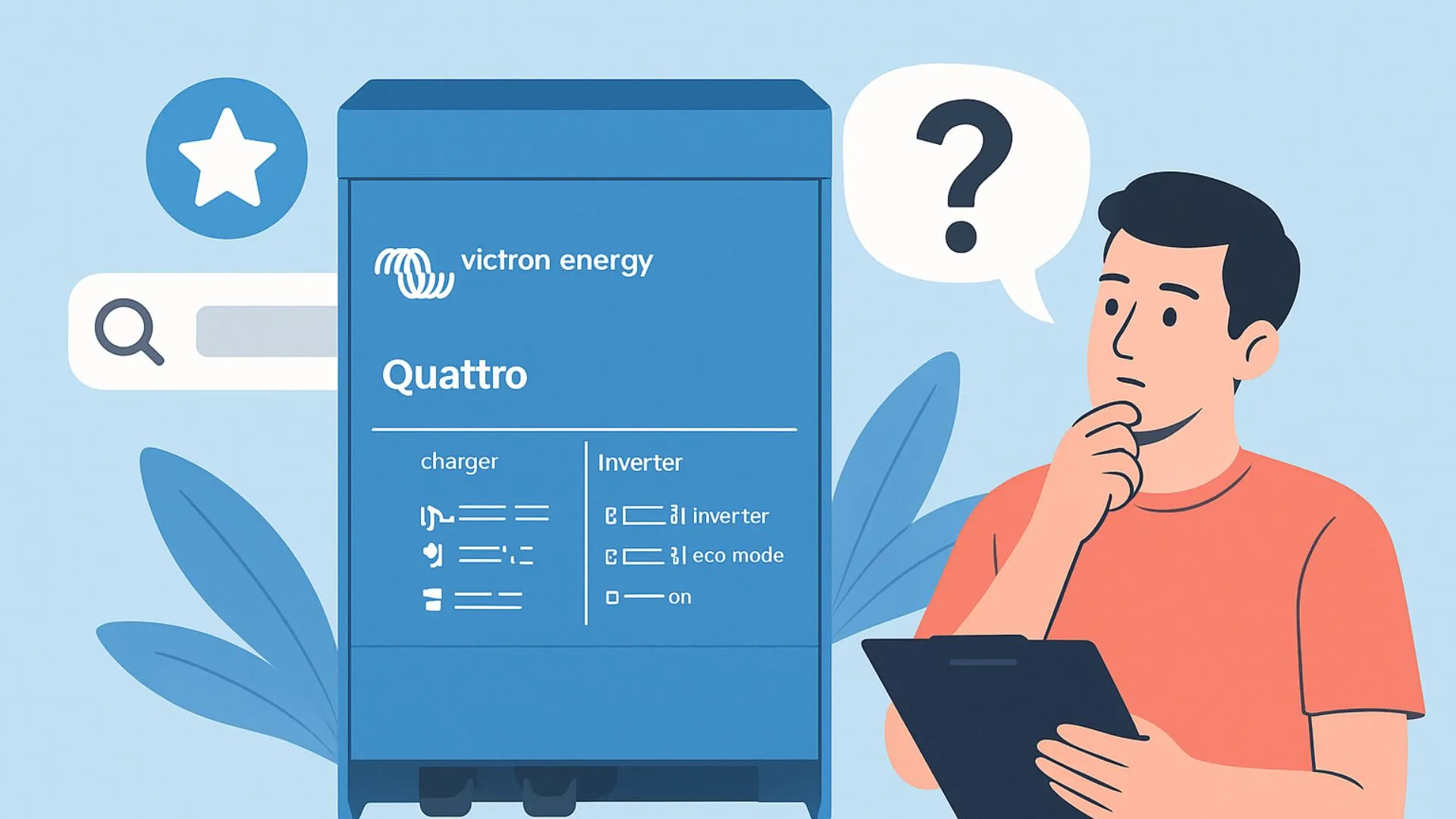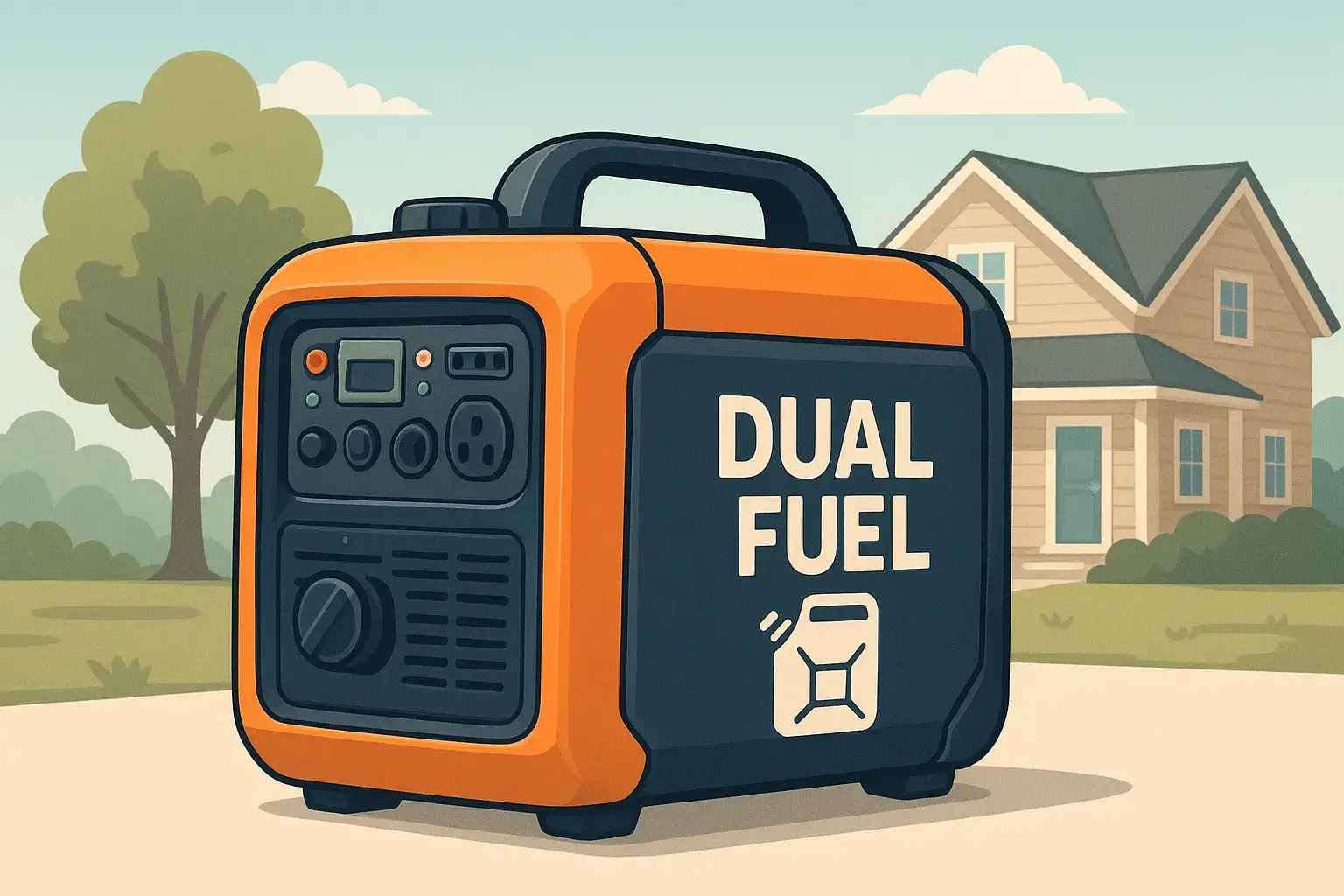Table of Contents
- Introduction 📜
- 1. What Is a Solar Generator?
- 2. Why Choose a Solar Generator for Home Backup?
- 3. Best Solar Generators for Home Backup in 2025
- 4. Comparison Table: Top Solar Generators for Home Backup
- 5. Use Case Breakdown: Which Generator is Best for You?
- 6. Buying Guide: What to Look For in a Solar Backup Generator
- Final Thoughts: Which Solar Generator Is Right for You?
- Frequently Asked Questions ❓
⚠️ When shopping for solar generators and power backups, we strongly recommend checking out Amazon's daily deals for potential savings. These promotions often change, so reviewing them before purchasing can help you find the best price on the right model. Make sure you don't miss out!
📌 This post may contain affiliate links, so we may receive compensation if you purchase products linked to below. As an Amazon Associate, I earn from qualifying purchases. This helps support our work and allows us to create more helpful content for you at no additional cost to you. Read our disclosure for more information.
Introduction 📜
As extreme weather events and grid instability become more common, having a reliable backup power source is no longer optional—it's essential. That's why more homeowners are turning to solar generators for emergency preparedness. In this guide, we break down the best solar generators for home backup in 2025, helping you choose a clean, quiet, and reliable power solution. Looking for more powerful, fuel-based options? Check out our Best Home Generators for Power Outages in 2025 for traditional gas and dual-fuel models.
1. What Is a Solar Generator?
A solar generator is a portable power station that uses solar panels to charge an internal battery, which then powers devices and appliances via AC, DC, and USB outlets. Unlike traditional gas generators, solar generators are emission-free, require no fuel, and operate silently, making them an ideal clean energy solution for backup power and off-grid living.
1.1 Components of a Solar Generator:
- Solar Panels: Photovoltaic (PV) panels capture sunlight and convert it into electricity. These are the core of any renewable energy system, whether it's off-grid or grid-tied.
- Battery Bank: Rechargeable lithium-ion or LiFePO4 batteries store excess solar energy for later use. Home energy storage ensures consistent power during the night or cloudy days, enabling energy independence.
- Charge Controller: This device regulates the voltage and current coming from the solar panels to the batteries, protecting them from overcharging and increasing their lifespan. MPPT charge controllers offer better efficiency.
- Inverter: Inverters convert DC power stored in batteries into standard AC power for running household appliances and electronics. Pure sine wave inverters are ideal for sensitive devices.
2. Why Choose a Solar Generator for Home Backup?
2.1 🌍 Clean, Renewable Energy
Solar generators don't produce harmful emissions and rely solely on the sun’s energy—making them an ideal choice for eco-friendly, environmentally conscious households seeking a clean, renewable backup power source.
2.2 🛎️ No Fuel Required
Forget fuel storage and panic-buying during storms. With a solar generator, you can rely on free, renewable solar power that provides a sustainable and hassle-free backup energy solution when you need it most.
2.3 🔌 Safe for Indoor Use
Unlike gas generators, solar power units don’t emit carbon monoxide or other toxic fumes, making them safe for use indoors or in enclosed spaces. This makes them a smarter, safer choice for home backup power, especially during emergencies.
2.4 💡 Quiet Operation
Perfect for nighttime power outages or apartment dwellers who need silent, indoor-friendly backup power. Solar generators offer a quiet, compact, and reliable solution for spaces where noise and fume-free operation matter most.
3. Best Solar Generators for Home Backup in 2025
1. Jackery Explorer 2000 Plus – Best Overall for Home Use
1. Jackery Explorer 2000 Plus
Pros
✓ Expandable & Powerful: The Jackery Explorer 2000 Plus supports up to 24kWh capacity and 6000W output by linking two units, making it ideal for whole-house backup and heavy loads like air conditioners and RVs.
✓ Durable LiFePO4 Battery: Uses safer, long-lasting lithium iron phosphate cells rated for about 4000 cycles and 10 years of use, with better performance in cold weather compared to Li-ion batteries.
✓ Smart App Control: The Jackery app lets you monitor and control the power station remotely via Bluetooth or Wi-Fi, offering convenience and real-time status updates.
Cons
✗ Weight & Portability: At around 61.5 lbs, it’s heavier than similar lithium-ion models, which may limit portability despite built-in wheels and handles.
✗ Cable Design: The cable connecting the battery pack to the main unit is bulky and sticks out significantly, making placement near walls or tight spaces difficult.
🔋 Jackery Explorer 2000 Plus – Best Overall for Home Use |
|
|---|---|
| 🔑 Battery | 2042Wh (expandable to 12kWh) |
| ⚡ Output | 2200W (4400W surge) |
| 🔁 Recharge Time | 2.5 hrs with 6x SolarSaga 100W panels |
| 🌟 Why It Stands Out |
✓ Expandable for whole-house power ✓ Easy to use with app control ✓ Excellent build quality |
| 🏠 Ideal For |
✓ Short to mid-length outages ✓ Powering fridge, TV, lights, medical devices |
2. EcoFlow DELTA Pro – Best for Whole-Home Backup
2. EcoFlow DELTA Pro
Pros
✓ High Power Output: Can deliver up to 4500W with X-Boost, powering heavy-duty appliances and multiple devices simultaneously.
✓ Fast Charging: Fully recharges in under 3 hours via wall outlet or solar panels.
✓ Smart App Control: Enables remote monitoring and customization via Bluetooth or Wi-Fi.
Cons
✗ Heavy: Weighs 99 pounds, making portability challenging despite built-in wheels and handles.
✗ Inconsistent Charging Speeds: Charging times can vary widely, with occasional slow charging.
🔋 EcoFlow DELTA Pro – Top Rated Portable Power Station |
|
|---|---|
| 🔑 Battery | 3600Wh (expandable) |
| ⚡ Output | 3000W (4500W with X-Boost) |
| 🔁 Recharge Time | Under 3 hours (wall outlet or solar panels) |
| 🌟 Why It Stands Out |
✓ High power output for heavy-duty appliances ✓ Fast charging via multiple methods ✓ Smart app control via Bluetooth/Wi-Fi |
| 🏠 Ideal For |
✓ Powering multiple devices simultaneously ✓ Users needing smart remote control ✓ Heavy-duty and emergency use |
3. Bluetti AC200MAX – Best Modular Option
3. Bluetti AC200MAX
Pros
✓ Expandable Capacity & Versatile Charging: Can expand battery capacity up to 8,192Wh and supports multiple charging methods — AC wall outlet, car charger, solar panels (even with just one panel), and lead acid battery. Dual charging allows faster recharge.
✓ Convenient Features & Connectivity: Includes Bluetooth connectivity and a smartphone app for remote monitoring and power management. Has multiple outlets (4 AC, 4 USB, 2 wireless chargers), a TT30 RV outlet, and a power-saving ECO mode.
✓ Robust Build & Power Output: High-quality LiFePO4 battery with reliable performance; can power heavy appliances including RV air conditioners with a soft starter. Well-designed touchscreen and solid packaging protect the unit during shipping.
Cons
✗ Heavy & Less Portable: The unit is quite heavy (about 62 lbs), making it less ideal for tent camping but manageable for car camping or RV use.
✗ Charging Time & Fan Noise: Full charge on grid power alone takes about 4 hours; solar charge time varies but can be slow with limited panels. The power supply fan runs continuously, which can be noisy.
🔋 Bluetti AC200MAX – Best Modular Option |
|
|---|---|
| 🔑 Battery | 2048Wh (expandable) |
| ⚡ Output | 2200W pure sine wave inverter |
| 🔁 Recharge Time | Dual input (solar + wall) in 2.5-3 hours |
| 🌟 Why It Stands Out |
✓ Compatible with Bluetti expansion batteries ✓ Wireless charging pads + multiple outlets ✓ MPPT solar input for high efficiency |
| 🏠 Ideal For |
✓ Off-grid setups ✓ Remote work ✓ CPAP users |
4. Anker SOLIX F2000 (PowerHouse 767) – Best for Durability
4. Anker SOLIX F2000 (PowerHouse 767)
Pros
✓ Highly Portable & Easy to Move: Wheels and telescoping handle make it convenient to transport, even for smaller or older users.
✓ Fast Recharge & Long Battery Life: Charges quickly (around 2.5 hours with 5 solar panels), and rated for 3000+ battery cycles with LiFePO4 battery technology that promises a 10-year lifespan.
✓ Powerful & Versatile Output: Supports up to 2400W with multiple AC and USB ports, powering various devices including refrigerators, CPAP machines, and even electric vehicles.
Cons
✗ Charging Issues with Inverters or Passthrough Charging: Some users experience problems charging the unit with certain modified sine wave inverters or while driving, limiting off-grid recharging options.
✗ App Reliability and Certain Use-Case Limitations: The app sometimes malfunctions, and specific applications like powering a 30-amp camper van might not work reliably.
🔋 Anker SOLIX F2000 (PowerHouse 767) – Compact & Durable |
|
|---|---|
| 🔑 Battery | 2048Wh LiFePO4 |
| ⚡ Output | 2400W pure sine wave inverter |
| 🔁 Recharge Time | ~2.5 hours with 5x Anker 200W solar panels |
| 🌟 Why It Stands Out |
✓ Rated for 3000+ battery cycles ✓ IP65 water-resistant solar panels ✓ Compact design with wheels and telescoping handle |
| 🏠 Ideal For |
✓ Apartment dwellers ✓ Mobile users |
5. Goal Zero Yeti 1500X – Most Portable Home Backup Option
5. Goal Zero Yeti 1500X
Pros
✓ Versatile Power Output: 997 Wh battery capacity with a 1500W pure sine wave inverter (3500W surge) powers a wide range of devices, from phones to small appliances.
✓ Durable & Portable: Heavy-duty anodized aluminum enclosure combined with a compact, portable design makes it ideal for camping, travel, and emergency use.
✓ Solar Recharge Compatible: Equipped with a 600W MPPT charge controller for efficient solar charging, allowing near-indefinite off-grid use when paired with solar panels.
Cons
✗ Not Suitable for Heavy-Duty Home Appliances: Some users experience problems charging the unit with certain modified sine wave inverters or while driving, limiting off-grid recharging options.
✗ Charging Heat Issue: Some users report that the AC charger gets very hot during use, requiring careful monitoring while charging.
🔋 Goal Zero Yeti 1500X – Reliable & Integrated |
|
|---|---|
| 🔑 Battery | 1516Wh |
| ⚡ Output | 2000W pure sine wave inverter (3500W surge) |
| 🔁 Recharge Time | 4-8 hours with solar |
| 🌟 Why It Stands Out |
✓ Reliable performance with app monitoring ✓ Integrates with Goal Zero ecosystem (fridges, lights) ✓ Solid choice for minimal setups |
| 🏠 Ideal For |
✓ Short-term outages ✓ Small households |
4. Comparison Table: Top Solar Generators for Home Backup
| Product | Battery (Wh) | Output (W) | Expandable? | Ideal For |
|---|---|---|---|---|
| 1. Jackery 2000 Plus | 2042 | 2200 | ✔️ | General Home Backup |
| 2. EcoFlow DELTA Pro | 3600 | 3600 | ✔️ | Whole-Home Backup |
| 3. Bluetti AC200MAX | 2048 | 2200 | ✔️ | Off-Grid, Custom Setups |
| 4. Anker SOLIX F2000 | 2048 | 2400 | ✖️ | Portability, Apartment |
| 5. Goal Zero Yeti 1500X | 1516 | 2000 | ✖️ | Minimalist Home Backup |
5. Use Case Breakdown: Which Generator is Best for You?
| Use Case | Recommended Solar Generator(s) |
|---|---|
| 🏠 Solar Generator for Homeowners (Fridge, Lights, Wi-Fi) | Jackery Explorer 2000 Plus or Bluetti AC200MAX |
| ⛺️ Solar Generator for RV & Vanlife | EcoFlow DELTA Pro with expansion battery |
| 🚜 Solar Generator for Emergency Kits / Apartments | Anker SOLIX F2000 or Goal Zero Yeti 1500X |
| 🏡 Solar Generator for Whole-Home Integration | EcoFlow DELTA Pro with Smart Home Panel |
6. Buying Guide: What to Look For in a Solar Backup Generator
| Feature | Description |
|---|---|
| ⚡ Battery Capacity (Wh) | Measured in watt-hours (Wh), a battery capacity of at least 1500Wh is recommended for powering home essentials and off-grid solar setups. |
| 🔌 Output Wattage (W) | Choose a portable power station with 2000W or higher output to efficiently run household appliances and devices. |
| ☀️ Solar Charging Speed | Look for MPPT solar charge controllers to ensure fast and efficient solar recharging, ideally under 4 hours for a full charge. |
| 💧 Battery Type | LiFePO4 (Lithium Iron Phosphate) batteries offer enhanced safety and longer lifespans, while Lithium-ion batteries are lighter and more compact but have shorter cycle lives. |
| 🌐 Ports & Connectivity | Essential ports include AC outlets, DC ports, USB-A/C, and wireless charging options. App control functionality adds convenience and remote monitoring. |
| ⌚ Lifespan & Warranty | Select power stations rated for 3000+ battery cycles with 2-5 year warranties to ensure durability and reliable performance. |
Final Thoughts: Which Solar Generator Is Right for You?
For an easy, quiet, and eco-friendly solution to keep your home powered during outages, solar generators are an excellent choice. Among them, the Jackery Explorer 2000 Plus stands out for delivering the ideal combination of power capacity, affordability, and expandability for most homeowners. If you require whole-home backup power, the EcoFlow DELTA Pro offers unmatched performance and reliability. Interested in exploring more options for reliable home power solutions? Visit our comprehensive guide on reliable home generators for power outages. Stay safe, stay powered, and make the switch to clean energy ☀️.
FAQs❓
1. Can A Solar Generator Power A Refrigerator?
+Yes, most solar generators with at least 1500 watt-hours (Wh) of battery capacity can power standard refrigerators. Depending on your fridge’s energy use, they can run it for 10 to 24 hours. Using energy-efficient fridges and proper solar charging extends runtime.
2. Are Solar Generators Safe To Use Indoors?
+Absolutely! Solar generators produce zero emissions and no carbon monoxide, making them safe for indoor use during emergencies, camping, or off-grid living.
3. How Long Do Solar Generators Last?
+Battery lifespan varies by type. LiFePO4 batteries often last 3000 to 6000+ charge cycles (10+ years), while lithium-ion batteries have shorter lifespans but are lighter and more compact.
4. Can I Use Any Solar Panel With A Solar Generator?
+Many solar generators accept third-party panels, but always check voltage, wattage, and connector compatibility (e.g., MC4 plugs) to ensure safe and efficient solar charging.
5. Are Solar Generators Worth It?
+If you want clean, quiet, renewable energy without storing fuel, solar generators are a great investment for camping, emergencies, home backup, and outdoor power needs.
6. How Do I Choose A Solar Generator?
+Assess your power needs—total watt-hours and peak wattage. Choose a solar generator with sufficient battery capacity (1500Wh+ for home use), high output, fast solar recharge (MPPT controller), multiple ports, and durable battery chemistry like LiFePO4.
7. What Is The Best Solar Generator To Purchase?
+The best model depends on your needs. Jackery Explorer 2000 Plus and Bluetti AC200MAX suit heavy home backup, while Anker SOLIX F2000 and Goal Zero Yeti 1500X are ideal for portability and emergencies. Consider battery size, output, and recharge speed.
8. What Will A 1000W Solar Generator Run?
+A 1000W solar generator can power laptops, phones, small refrigerators, LED lights, TVs, and medical devices—great for camping and short outages but may not support heavy appliances like large microwaves or air conditioners.
9. What Can A 200W Solar Generator Run?
+A 200W solar generator handles small electronics such as smartphones, tablets, LED lights, laptops, and fans. Perfect for camping and outdoor charging but insufficient for large appliances or long use.
10. Can A Solar Generator Power A Home?
+Solar generators can power essential home devices during outages, especially with high-capacity batteries and solar panels. For full whole-home backup, they usually need integration with larger systems or smart home panels.
11. What Is The Difference Between A Solar System And A Solar Generator?
+A solar system includes panels, inverters, and batteries that feed electricity into your home or grid. A solar generator is a portable unit combining a battery, inverter, and solar charging, designed for mobility and off-grid use.
12. What Is The Difference Between A Solar Generator And A Power Bank?
+Solar generators have large batteries and AC/DC outlets for powering appliances. Power banks are smaller chargers for USB devices like phones and tablets, without high wattage or solar integration.
13. How Does Solar Power Generation Work?
+Solar panels convert sunlight into DC electricity using photovoltaic cells. An inverter converts this to AC electricity for use in homes, devices, or battery storage, providing clean, renewable energy.
14. How Does A Solar Generator Work?
+A solar generator stores solar energy in a battery and converts DC power to AC power via an inverter to run electrical devices. Charge controllers optimize solar input for efficient battery charging.
15. How Does Solar Generate Electricity?
+Solar generates electricity when photons from sunlight knock electrons loose in photovoltaic cells, creating electrical current without emissions or fuel.
16. Does A Solar Generator Need Fuel?
+No. Solar generators do not require gasoline, propane, or diesel fuel. They rely solely on sunlight to recharge batteries, providing clean, quiet power.
17. How Do Solar Generators Work At Night?
+At night, solar generators supply power from their stored battery energy until solar panels recharge them during the next daylight period.
















